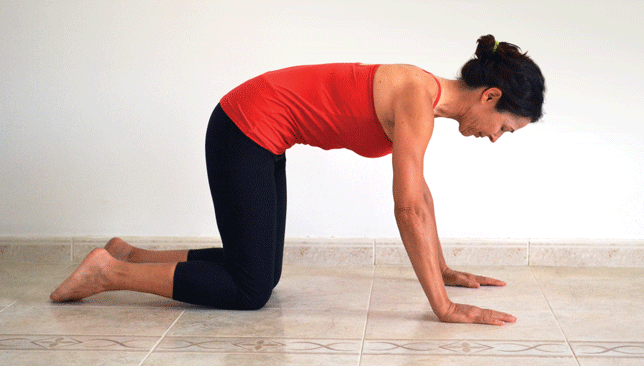Common faulty postures can lead to chronic back, neck and shoulder pain amongst other health problems, but most can be improved if not corrected with just a few well-chosen exercises practiced regularly.
This refers to an exaggerated concave curve of the lumbar region of the spine and often goes hand in hand with a kyphosis, the exaggerated convex curve of the middle/upper spine, the first of the faulty postures we looked at earlier this month. The lower back muscles and hip flexors (where the front of thigh meets the front of hip) tend to be short and tight, pulling the pelvis into an anterior tilt. The abdominal muscles and the gluteals (buttocks) tend to be weak.
Pelvic Tilts
This will help stretch the tight lower back.
- Start on your hands and knees. Keep your line of vision between your fingers and keep the upper body still as you exhale and tuck the tailbone under, rounding out the lower back. Inhale back to neutral. DO NOT TILT TAILBONE UP. Repeat 10 times
- Imagine a small puddle of water in the small of your back in neutral, tailbone stretching directly back rather than up. When you tilt, all the water is lost.
Plank
Targets abdominal muscles without involving the hip flexors.

- Resting on your forearms, move your knees back until your body is parallel to the ground and remember the small puddle of water. You don’t want a deep puddle so adjust the pelvis although this may feel strange to begin with.
- As you exhale, engage your abdominal muscles, tuck your toes and attempt to stretch your legs so that your knees lift WITHOUT ALLOWING YOUR LOWER BACK TO SINK. Inhale to return your knees to the ground. Repeat up to 10 times.
- The torso must remain still at all times. You may not get your knees off the ground at first. No pain in your back.
Hip Flexor Stretch

From hands and knees, stretch one foot forward and bring your hips forward so that the back thigh is on a diagonal. Your front knee must remain behind your front toe. Rest your hands on your front thigh. Hold for 5 slow breaths and switch legs.


